Tarzan-on-Demand: Tarzan and the Great River (1967)
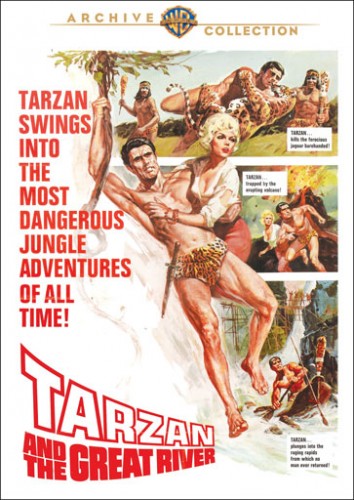 Tarzan and the Great River (1967)
Tarzan and the Great River (1967)
Directed by Robert Day. Produced by Sy Weintraub. Starring Mike Henry, Jan Murray, Rafer Johnson, Manuel Padilla Jr., Diana Millay.
Other Tarzan MOD DVD reviews: Tarzan’s Greatest Adventure, Tarzan the Magnificent, Tarzan and the Valley of Gold (plus the Fritz Leiber novelization).
The second Tarzan movie starring former NFL linebacker Mike Henry as the Ape Man, Tarzan and the Great River (available through Warner Archive, WB’s manufacture-on-demand division) reached theaters a year after the previous installment, Tarzan and the Valley of Gold, but was shot directly after it on location in Brazil. Producer Sy Weintraub continued to emphasize a modern Tarzan with aspects of the globe-trotting James Bond films, but Tarzan and the Great River eases back on military machinery and super villains and instead targets a stripped-down jungle chase story that Edgar Rice Burroughs would have found familiar. This doesn’t end up making for a better film, unfortunately.
Tarzan and the Great River opens with its most overt gesture toward the espionage movies of the era: Tarzan receives a summons from across the globe, and dressed in a snappy suit arrives in Brazil at the behest of an old friend, a professor at a zoological garden. The professor needs Tarzan to investigate a growing Jaguar Cult in the Amazon that has started to enslave local tribes. But while Tarzan takes the time to meet some of his African animal friends who reside at the zoo, the professor ends up dead on the poisoned claws of one of the cult’s wicked jaguar cubs. Tarzan now has vengeance on his mind as he travels deep into the Amazon rainforest to locate the cult’s leader, the cruel Barcuna (Rafer Johnson), in the company of the chimp Cheetah and the lion Baron. (The same animal performers who played “Dinky” and “Major” in the previous film.)
To travel faster along the great river of the title, Tarzan hitches a ride on the skiff of Captain Sam (comedian Jan Murray) and his young first mate, Pepe (Manuel Padilla Jr. from Tarzan and the Valley of Gold), who are transporting medicine crucial to curing a plague among a village near Barcuna’s campaign of terror. Along the journey, they also pick up Dr. Ann Phillips (Diana Millay, a regular on Dark Shadows), the physician tasked with helping the natives against the disease.
In a number of aspects, Tarzan and the Great River rises above the previous Mike Henry film. The photography is lusher, taking fuller advantage of the Amazonian location shoot to create a beautiful rainforest setting that’s perfect for Tarzan. It also has a more robust and romantic score, and the animal action goes a step beyond some of the already impressive scenes from Tarzan and the Valley of Gold. (Although the animal performers caused a serious production problem. More on that later.) The main villain Barcuna is also a more Burroughs-style villain than the James Bond knock-off Augustus Vinero from Valley of Gold.
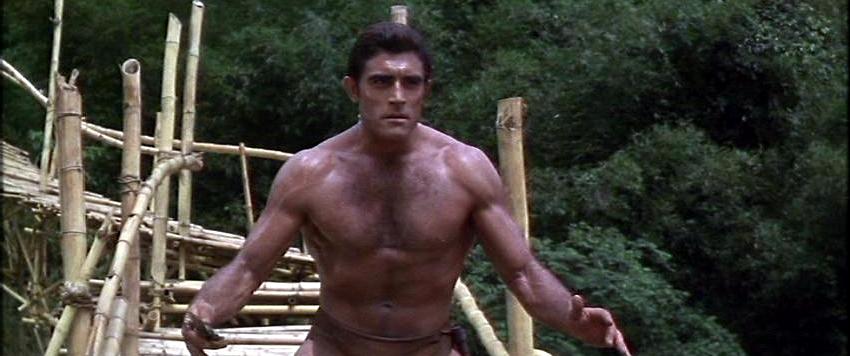 However, in the majority of ways that count with viewers — story, pacing, characters — this is substantially the weaker film. It’s easily the poorest of the “New Look” Tarzan movies from producer Sy Weintraub that I’ve watched so far. There is some entertainment lurking around here, and Mike Henry still shows that he is (physically) the best on-screen Tarzan. The problem is that the story lacks urgency and has placed too much focus on a comic actor who isn’t capable of pushing forward a jungle adventure.
However, in the majority of ways that count with viewers — story, pacing, characters — this is substantially the weaker film. It’s easily the poorest of the “New Look” Tarzan movies from producer Sy Weintraub that I’ve watched so far. There is some entertainment lurking around here, and Mike Henry still shows that he is (physically) the best on-screen Tarzan. The problem is that the story lacks urgency and has placed too much focus on a comic actor who isn’t capable of pushing forward a jungle adventure.
You can’t blame Jan Murray too much for his misuse in Tarzan and the Great River. He does what he was hired to do: play a colorful boat captain with a humorous salty-dog delivery. But Murray was the wrong actor for the job. His Borscht Belt comic style makes the character of Captain Sam feel like an intruder from a ‘60s sitcom with no place in a Tarzan tale, especially the more realistic series Weintraub created. A rougher-edged character actor better capable of balancing comedy and drama would have suited the role better. Murray eventually becomes a handicap and every moment spent with Captain Sam after the mid-point feels too long. The character should have died earlier during a Barcuna attack, leaving young Pepe “orphaned” and needing to rely on Tarzan while learning independence.
The late Manuel Padilla Jr. delivers a more natural performance here than he did in Tarzan and the Valley of Gold, and as with Murray it isn’t completely the fault of the actor that the part doesn’t click. The movie sacrifices its suspense and forward drive to fiddle about with the drama between Pepe and Sam, and this sublimates Tarzan and his fight to reach Barcuna to second-string status. The addition of Dr. Phillips worsens the situation, since the script immediately folds her into the Pepe and Sam plot, where she pressures Sam to turn into a better man who doesn’t think of making a buck first and on Pepe to seek an education. This isn’t a terrible idea for character drama… if this were a lighter children’s adventure story in the live-action Disney mold. But it’s murder on pacing for a jungle action tale pitting Tarzan against a genocidal Jaguar Death Cult.
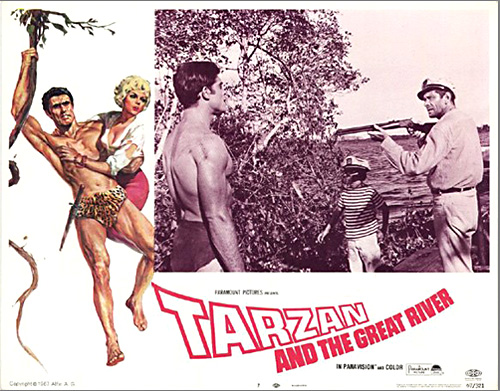 Barcuna and his followers should make for superb villains, and in the early scenes where we see their cruelty (killing the professor, roasting a villager over an enormous pit) they seem capable of remaining exciting foes. But the movie starts to forget that they exist; by the time Tarzan reaches Barcuna’s headquarters, the Jaguar Cult feels like afterthoughts to the story of Captain Sam learning a lesson about ethics and what’s best for Pepe. Tarzan simply walks into the Jaguar Cult camp, challenges Barcuna to a man-to-man duel (the first time the two characters have even met), and has the obligatory fight to the death. It’s an underwhelming result based on the expectations the movie established in its opening scenes.
Barcuna and his followers should make for superb villains, and in the early scenes where we see their cruelty (killing the professor, roasting a villager over an enormous pit) they seem capable of remaining exciting foes. But the movie starts to forget that they exist; by the time Tarzan reaches Barcuna’s headquarters, the Jaguar Cult feels like afterthoughts to the story of Captain Sam learning a lesson about ethics and what’s best for Pepe. Tarzan simply walks into the Jaguar Cult camp, challenges Barcuna to a man-to-man duel (the first time the two characters have even met), and has the obligatory fight to the death. It’s an underwhelming result based on the expectations the movie established in its opening scenes.
If viewed in isolation, the tussle between Tarzan and Barcuna works. As with the other Sy Weintraub Tarzan movies, the action emphasizes the actual performers involved in violent close-quarter stunts that look painful for both. Seeing two men in the sort of shape as Mike Henry and Rafer Johnson — both of them world-class athletes in their prime — fly into face-crunching fisticuffs and full body blows along a rickety wood frame over boulders and a waterfall is the action you expect from the classic days of adventure movies. It’s unfortunate that so little is dramatically invested in the fight. Compare it to Tarzan’s Greatest Adventure, which perfectly establishes the tension between old adversaries Tarzan and Slade and Slade’s growing desperation until the two face off, and the finale of Tarzan and the Great River feels paltry and almost a footnote.
In fact, the filmmakers appeared to have thought the dramatic highlight of the story would be Pepe bravely agreeing to receive an injection of medicine from Dr. Philips to show the superstitious villagers that the visitors want to help them. As a piece of drama placed earlier in the movie, this might have been a good moment. But positioned as the character culmination before the action climax, it’s a snooze. The arrival in the village, which was the original goal of all the heroes, should carry the weight of Barcuna’s slave-gathering rampages. Instead, the Jaguar Cult is sidelined at this point and seems to have no impact on the village at all. The tension comes down to whether Pepe is brave enough to let a doctor give him a shot. Frankly, the drama of an average pediatrician’s office on any given day is inappropriate as the climax for a Tarzan adventure.
Perhaps I’m overstating the case a bit, since Tarzan and the Great River is by no means a “bad” film. It simply isn’t a gripping one that will hook viewers into its story enough to carry them along the rapids of the Amazon. An eighty-eight minute adventure movie needs more tension and suspense (and actual action) to sweep the audience along, and this movie only has sporadic moments of those elements.
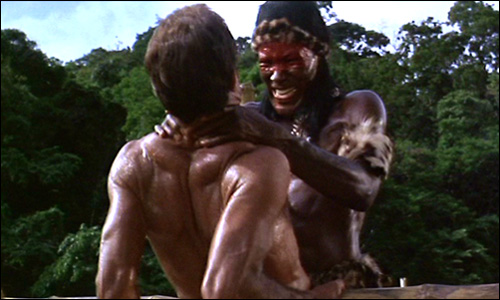 Mike Henry again shows what an excellent choice he was for the part, even with a script that doesn’t allow him much room to stretch. His Tarzan is physically capable of everything we see him do, and his dark handsomeness and pantherish build make him almost the perfect image of Burroughs’s character — just with hair that’s too short. Henry doesn’t have a firm hand on the dialogue scenes, and it’s a shame the movie didn’t give him more interesting interactions with the other characters (Couldn’t we at least have some sexual tension with Ann?) to allow him to explore his acting capabilities further.
Mike Henry again shows what an excellent choice he was for the part, even with a script that doesn’t allow him much room to stretch. His Tarzan is physically capable of everything we see him do, and his dark handsomeness and pantherish build make him almost the perfect image of Burroughs’s character — just with hair that’s too short. Henry doesn’t have a firm hand on the dialogue scenes, and it’s a shame the movie didn’t give him more interesting interactions with the other characters (Couldn’t we at least have some sexual tension with Ann?) to allow him to explore his acting capabilities further.
Rafer Johnson, Olympic gold medalist, has the same issues as Mike Henry. An amazing physical presence, not so adept at delivering dialogue. Barcuna seems significantly less threatening every time he speaks, sounding like a guy who grew up near Fresno (Johnson’s family moved there when he was five) instead of a primal Amazonian god figure. But he was cast principally to look menacing and Johnson pulls that off. A more substantial version of Barcuna might have made for a first-class villain.
Animal stunts are a major part of the history of the Tarzan movie franchise and Tarzan and the Great River has an abundance of animal work done in close quarters with the cast. Some of it is annoying comedy between two chimpanzees, but the scenes with Baron are impressive for how Mike Henry and Manuel Padilla Jr. work in such physical harmony with an actual lion.
There are two downsides to the animals, however. First is the abundance of nature stock footage that kills time while the boat putters up river. Not only is the footage obviously older and worn, but it frequently violates geography with animals that have no business in the Amazon. Watching Tarzan race to break apart a tussle between lions that is supposed to occur near Dr. Phillips should be exciting… except that wild lions don’t exist in South America and it’s difficult to ignore this glaring error. (Burroughs made a similar one in the first published version of Tarzan of the Apes, where he placed tigers in Central Africa. All later versions changed the tigers to she-lions.)
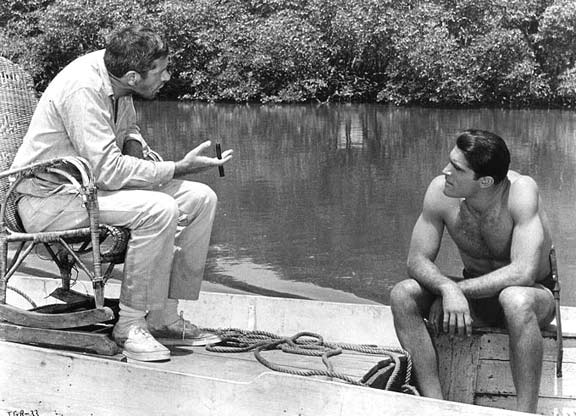 The second trouble with the animal stunts led to Mike Henry leaving the series after only three films. While shooting this movie, the chimpanzee playing Cheetah viciously ripped open Henry’s jaw with its teeth. The actor needed twenty stitches and the wound became infected, resulting in a string of other health problems that plagued shooting this film and the next, Tarzan and the Jungle Boy. This was the major incident in a series of troubles during production of the films in Brazil that led to Mike Henry unsuccessfully suing Sy Weintraub’s Banner Productions for creating unsafe working conditions. (“[M]altreatment, abuse, and working conditions detrimental to my health and welfare,” according to the wording of the $800,000 suit.) Henry was originally slated to play the Ape Man on the subsequent television series, but because of health problems and the delirious scheduling, he turned the role down. Ron Ely took the part instead.
The second trouble with the animal stunts led to Mike Henry leaving the series after only three films. While shooting this movie, the chimpanzee playing Cheetah viciously ripped open Henry’s jaw with its teeth. The actor needed twenty stitches and the wound became infected, resulting in a string of other health problems that plagued shooting this film and the next, Tarzan and the Jungle Boy. This was the major incident in a series of troubles during production of the films in Brazil that led to Mike Henry unsuccessfully suing Sy Weintraub’s Banner Productions for creating unsafe working conditions. (“[M]altreatment, abuse, and working conditions detrimental to my health and welfare,” according to the wording of the $800,000 suit.) Henry was originally slated to play the Ape Man on the subsequent television series, but because of health problems and the delirious scheduling, he turned the role down. Ron Ely took the part instead.
If you know this behind-the-scenes story, it’s difficult to watch the actors in close proximity to the animals and not wonder how much worse things might have gone if the safety on the set were as slapdash as Henry accused it of being. Each time Pepe asks if he can “pet the lion” comes with a chill that has nothing to do with the storyline.
The movie’s poster features outright and disappointing fabrications. Tarzan trapped by the erupting volcano! No, no volcanic eruption. No volcano at all. Tarzan kills the ferocious jaguar barehanded! No, he wrestles some lions that apparently got very lost from the African veldt, but no jaguar fights. I wonder if the marketing team was confusing the three Tarzan movies shot at the same time, or if they knew that the tagline Watch Tarzan encourage a young boy to let a doctor give him a shot! wouldn’t pull in viewers off the streets, no matter how well air-conditioned the theater.
Gratuitous personal note: Rafer Johnson’s daughter Jennifer, who later became an Olympic medalist herself for women’s volleyball, was in my junior high and high school class (she’s now the school’s assistant volleyball coach). Rafer was a regular fixture at school events, and even played the small part of Santa Claus in a seventh-grade school play I was in. He was the nicest and most affable guy you could imagine, and he always remembered my name when he saw me, and so I feel sorry for criticizing his line delivery here. I can remember how thrilled all of us at school were when he showed up in a James Bond film, Licence to Kill. Wow, we know a guy who was in a Bond movie!
Anyway, Mr. Johnson’s in the next Tarzan film as well, Tarzan and the Jungle Boy, so let’s just move on to that.
Ryan Harvey is one of the original bloggers for Black Gate, starting in 2008. He received the Writers of the Future Award for his short story “An Acolyte of Black Spires,” and his stories “The Sorrowless Thief” and “Stand at Dubun-Geb” are available in Black Gate online fiction. A further Ahn-Tarqa adventure, “Farewell to Tyrn”, is currently available as an e-book. Ryan lives in Costa Mesa, California where he works as a professional writer for a marketing company. Occasionally, people ask him to talk about Edgar Rice Burroughs or Godzilla in interviews.
“…by the time Tarzan reaches Barcuna’s headquarters, the Jaguar Cult feels like afterthoughts to the story of Captain Sam learning a lesson about ethics and what’s best for Pepe.”
Gah. Why, O Lords of Narrative, why does this kind of thing happen so often?
Is there some kind of deep-seated desire in the storytellers to sidestep the thrills and deliver something Truly Uplifting to the audience they lured in with the promise of thrills?
Or are they just not comfortable telling a ripping action yarn?
Or do they simply not sense the difference between the kind of story their audience would expect and the one they’re telling?
Disappointing no matter how you look at it.
Speaking of “lured in with the promise of thrills,” I was pretty excited about the prospects of a volcano. Nothing better to close out an adventure movie than an erupting volcano. It’s a classic, but a classic for a reason.
So where is my damn volcano?
As I mentioned in the comments, Sy Weintraub has 10 Producer credits: 8 Tarzan and 2 Sherlock Holmes. Ol’ Sy went big or went home.
http://www.blackgate.com/2014/03/24/the-public-life-of-sherlock-holmes-the-case-of-the-short-lived-holmes/